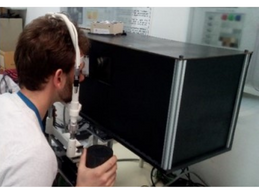Non–invasive method for the objective assessment of the intraocular scattering of the cornea and the crystaline lens.
A new method has been developed for the assessment of the intraocular scattering generated in each structure of the human eye, i.e., the cornea and the crystalline lens. Ref: MKT2019/0165_I

The Challenge
Retinal image quality is the first limit to human visual performance, being affected by aberrations and scattering. The contribution of the latter has a great impact since it reduces the contrast of the retinal image and produces loss of vision, which is manifested in different diseases such as cataracts and some corneal disorders. Laser refractive surgery and intraocular lenses implantation can also increase the level of scattering. Nowadays, the most common tests used in clinical practice for the measurement of intraocular scattering are subjective, as the measurement of visual functions (Visual Acuity, Contrast Sensitivity Function) or the observation of the eye through a slit-lamp. Few instruments have been developed in the last years that allow the objective measurement of intraocular scattering as a whole, that is, that corresponding to the whole eye. Hence, there is a need for objective, non-invasive methods that permit to separate the contribution of the cornea and the crystalline lens to the overall intraocular scattering.
The Technology
The system is based on recording images of the reflection on the ocular surfaces (Purkinje Images) of the light coming from an object, preferably opaque, which includes areas that allow light to pass to a greater or lesser degree, so that light is received in the eye in a series of clear and dark distinct areas. The analysis of the contrast in the Purkinje images, mainly P3 (reflection on the anterior surface of the crystalline lens) and P4 (reflection on the posterior surface of the crystalline lens), allows quantifying the intraocular scattering due to both the cornea and lens. The technology is objective and non-invasive. It overcomes the limitation of just having a global evaluation of the scattering of the eye, allowing the discrimination of the contribution of the cornea and the crystalline lens.
Innovative advantages
- Assessment of the scattering due to the cornea and the crystalline lens separately.
- Non-invasive and objective measurement.
- Can be incorporated to an existing device as a module or implemented as a standalone instrument.
Current stage of development
A preclinical prototype is available.
Applications and Target Market
Business opportunity for companies devoted to development of ophthalmic diagnostic equipment and ophthalmologic instrumentation.

New system for the assessment of intraocular scattering of the cornea and crystalline lens.

Non-invasive and objective measurement. Can be incorporated to an existing device as a module or implemented as a stand-alone
Patent Status
PCT application
Contact
Sonia Touriño, PhD
Licensing Manager
T. + 34 9337630
Sonia.tourino@upc.edu
Comparteix: